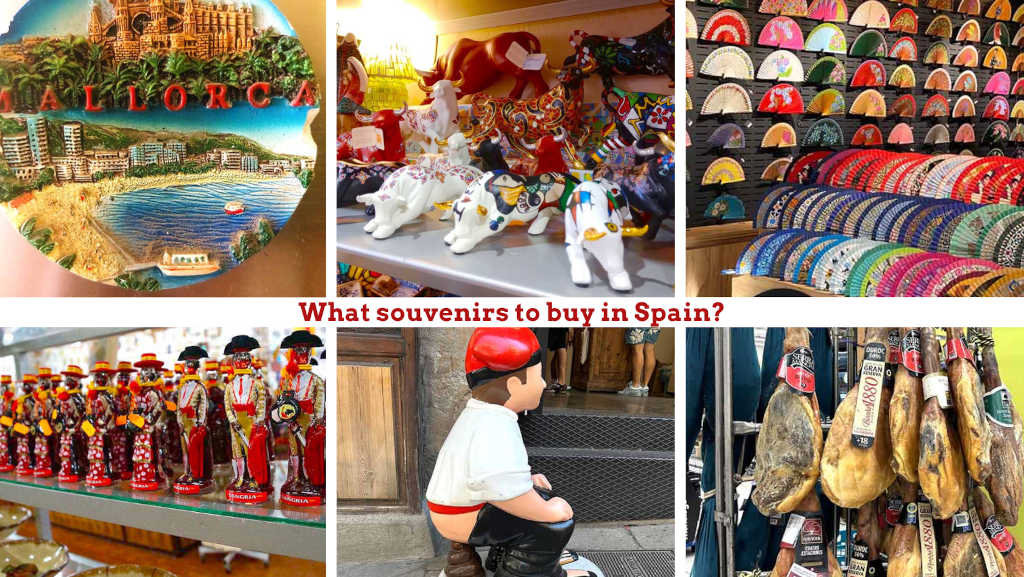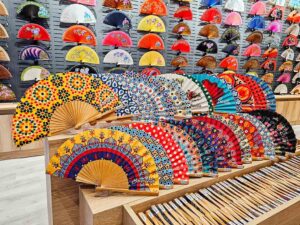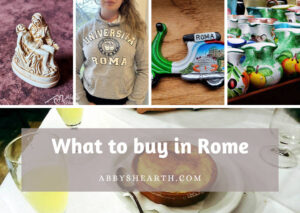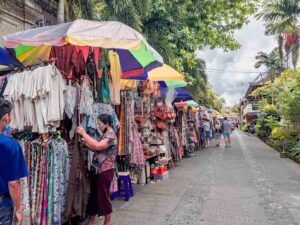Rich culture, magnificent churches, beautiful landscapes and stunning beaches are not the only draw to Spain. With it’s historic sites and fascinating architecture, Spain offers the curious visitor a one-of-a-kind experience of art, history and culture. But what do you bring back home with you from Seville or Barcelona or Mallorca or anywhere else in Spain? From unique mememtos like el caganer to bottles of wine and abanicos, here are some of the Spanish souvenirs to cart back home with you.
1. Fridge Magnets

Pic by Abby from Abby’s Hearth
A fridge magnet is much more than a cheesy souvenir. It’s a cute little reminder of your time in Spain. Plus, it’s great for holding post it notes with lists of things to do or photos of loved ones or drawings by nieces and nephews.
Magnets are also an economical way of appeasing the dozens of relatives who expect you to come back with a gift for them. I got this magnet featuring Mallorca while visiting the brother and his wife back in 2017, and it’s chipped quite a bit, but it’s still great to have around!
2. Turron
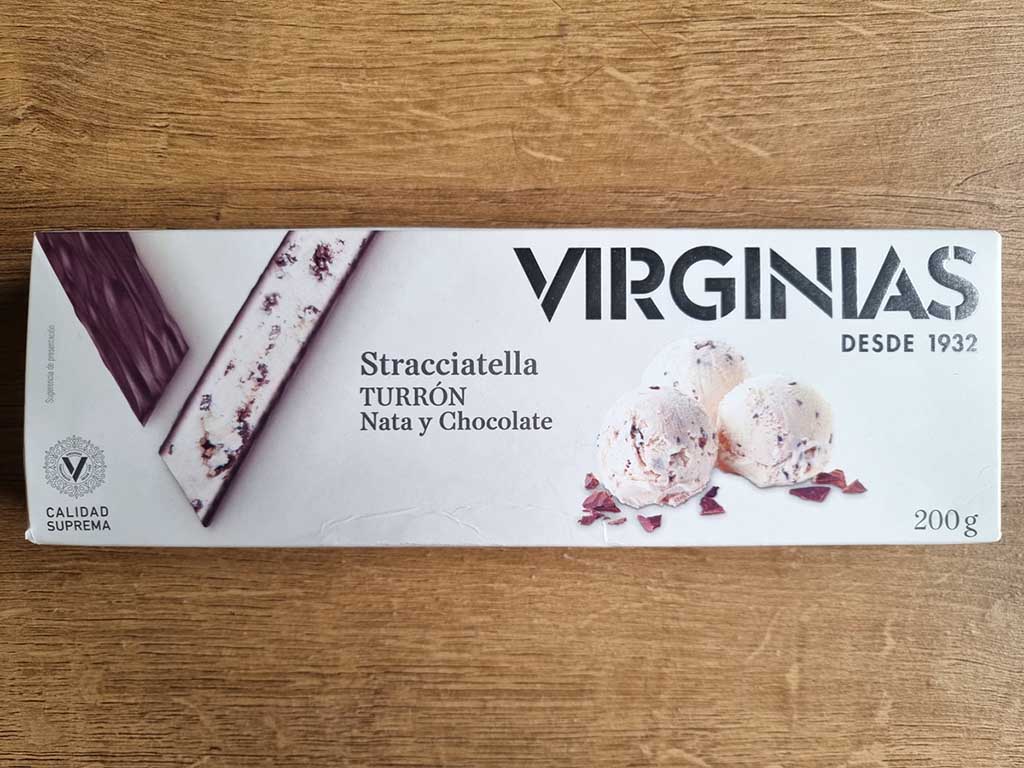
Pic by Joanna from The World In My Pocket
Turron makes a wonderful souvenir from Spain, especially if you are visiting Sevilla in winter. Turron is a traditional nougat sweet typically associated with festive occasions such as Christmas or Easter. It is made from almonds, though other nuts can be used as well, honey, sugar, and egg whites. The mixture is cooked, poured into moulds, and allowed to cool and set before being cut into individual portions.
Turron comes in various forms, with the two most common types being “Turron de Jijona” and “Turron de Alicante.” Turron de Jijona is a soft and chewy variety, while Turron de Alicante is a harder and more brittle version.
The best places to buy turron are the Sabor a España shops, which you will find spread all over the main cities in Spain. You can’t miss them because they are always cooking something, spreading a lovely sugary aroma in the air. They also give away plenty of samples, so you can try the turron before you buy it.
By Joanna from The World In My Pocket.
3. Chorizo

Pic by Timon from Travel Spain 24
Chorizo is a type of Spanish sausage made with bacon, pork meat and seasoning including paprika and garlic. While this is an expensive delicacy back home, it is readily available in almost any Spanish supermarket. This makes it a great option as an iconic Spanish souvenir.
Chorizo is available in different sizes of sausage and different styles including horse shoe shaped, sliced in a packet and tapered candle. Each region also has its own recipe, so there are some subtle and not so subtle different flavors depending on where your chorizo comes from. If you want to try the traditional chorizo, look for chorizo Español, which is still made using the traditional curing processes dating back to the 17th century.
If you’ve never tried Spanish chorizo and you’re unsure if you’ll like it, be sure to check out the menus at local cafes and restaurants, which inevitably will have chorizo dishes including cocido, a traditional chorizo based stew.
By Timon from Travel Spain 24.
4. Olive Oil

Pic by Abby from Abby’s Hearth
Spain has been producing olive oil for over 3000 years, and is the biggest producer of olive oil in the world. All of them have different tastes and flavors and are all of different intensities from regular olive oil to extra virgin to olive oil.
The perfect thing to drizzle over salads or tacos or starters or fry your nuts in (no pun intended), or to use in tantalising dishes like the paella, there are many brands of olive oil that you can bring back home. Some famous types are Hojiblanca, Cornicabra, Picual, Lecihn and Arbequina.
Some famous brands of olive oil are Castillo de Canena, Borges Olive Oil, Oro Bailén, Castillo de Canena Picual Olive Oil, Venta del Barón, Garcia de la Cruz, and Oro del Desierto. We always bring back many bottles when we visit Spain, for different stages of cooking.
5. Moorish Tiles

Pic by Becki from The Seville Guide
If you’re planning on visiting Seville, Granada or Cordoba in the enchanting region of Andalucia, in southern Spain, you’re in for a cultural treat. The region was once under Moorish rule, and you’ll see buildings such as the Alhambra, and Alcazar of Seville adorned with intricate Arabic inscriptions and designs.
One of the best souvenirs to bring home is traditional Moorish tiles, known as zellige or azulejo tiles.
These tiles are a true reflection of the rich Islamic history of the region. Influenced by Moorish design, they feature bold geometric patterns that create an intricate mosaic of colours and shapes.
Whether used as coasters, trivets, or wall decorations, these tiles are a beautiful way to remember your travels and bring a piece of Andalucian charm into your home.
By Becki from The Seville Guide.
6. Sangria mini bottle

Pic by Paulina from the UK Every Day
Don’t miss the opportunity to bring home a piece of Spain with you by purchasing a mini bottle of sangria from Barcelona or Mallorca. This delightful beverage is a popular choice among locals and tourists alike, and it captures the essence of Spanish culture and tradition.
The mini bottle is not just a cute souvenir, but it’s also incredibly practical for travelers. Its compact size makes it easy to fit in your luggage, ensuring that you can bring a piece of Spain back home with you. And whenever you pour yourself a glass of sangria, you’ll be transported back to the lively and vibrant atmosphere of Spain.
By Paulina from the UK Every Day.
7. Painting from a local artist

Pic by Jennifer from Illuminated Experiences
Each Sunday in Madrid, locals and tourists flock to El Rastro, a sprawling outdoor flea market with over 1000 merchants in the La Latina neighborhood. El Rastro, held in the city centre, has been a tradition for over 400 years.
There are streets where you will find paintings by local artists, frames and art supplies. Antiques, ceramics, clothing, records, household goods, and nearly every other type of souvenir are also for sale. You can also find local art for sale on the street near Plaza Mayor.
A painting is an authentic souvenir to remember a place you have visited long after your trip. Local artists appreciate these purchases to support their livelihood. Smaller canvases are rolled and placed in a small tube for travel which makes them ideal to transport home even in a carry on bag. Larger paintings can often be shipped to your home address by the artist.
By Jennifer from Illuminated Experiences.
8. Spanish Bull Figurine

Pic by Deeptha from The Globe Trotter
While bullfighting is banned in some regions of Spain, including Catalonia, it has deep cultural roots in other parts of the country. As a result, you will notice that various bull-themed souvenirs that reflect Spain’s historical connection to bullfighting are stocked in most souvenir shops.
Miniature statues or figurines of bulls often made from materials like porcelain, ceramic, resin, glass or metal are popular. Some are simple, some are intricate, some are handmade and some feature colourful artwork like the one pictured below. You can pick up these from almost all souvenir shops or from flea markets found in cities like Barcelona or Madrid.
By Deeptha from The Globe Trotter.
9. Spanish Gold Jewelry

Pic by Zhen from Greedy Gourmet Girl
Gold jewlry is a great souvenir from Spain because it’s of historic and cultural significance to the country. Gold has been part of Spain’s history for centuries: thousands of years ago, the Celts that inhabited the land that is modern-day Spain were known for their jewelry-making skill, crafting exquisite creations such as gold torcs. Later, in 700BC, we find the first record of gold trading in Spain, when the Phoenicians traded their tools and glass beads for Spanish gold.
However, the real “golden age” os Spain was between the 15th and 17th centuries, when gold and silver flooded the country, thanks to their colonization of South America, which is rich in precious metals. (At its peak, Spain controlled half of South America and a good portion of Central and North America.) This led to masses of beautiful and intricate gold jewelry being worn by the Spanish.
Whilst some of the gold jewelry is obviously very expensive, there are many affordable pieces in Spain made for the tourist market, so that you can have a meaningful but affordable souvenir from your travels. Plus, expensive or not, gold jewellery is a durable keepsake that you can pass down to future generations! Better than tourist twat anytime!
By Zhen from Greedy Gourmet Girl.
10. Hand Fan from Seville
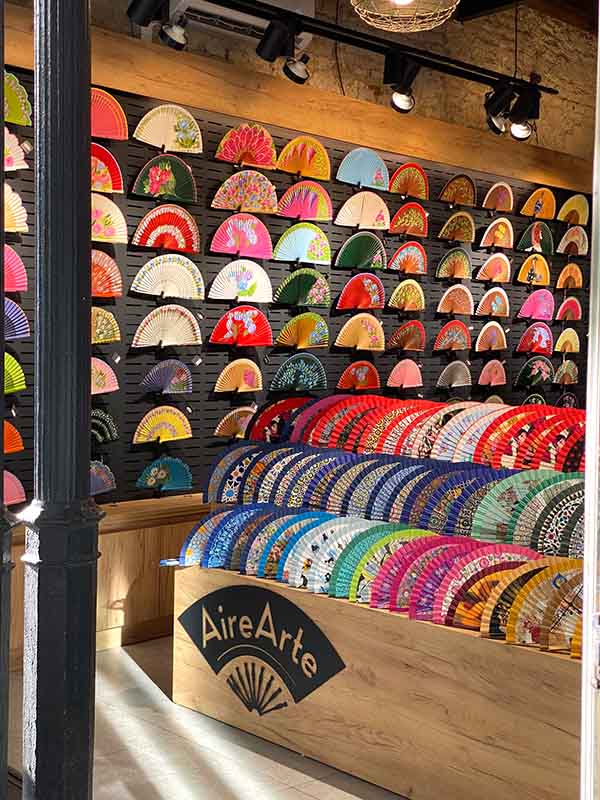
Pic by Tina from Veganderlust
Spain is known for flamenco and hot weather. So what better souvenir to bring back from Spain than a Spanish fan? The hand fan used in flamenco dancing.
You can try to dance flamenco yourself, and in case it doesn’t work out you can just use it to cool off while exploring sunny Spain.
The best place to buy a Spanish fan in Spain is Seville. This beautiful city in Andalusia, the home of the flamenco dance, is known for its lively atmosphere and its flamenco dancers.
So make sure to visit a flamenco show during your visit to this beautiful city and buy a hand fan as a reminder of your days in Seville.
By Tina from Veganderlust.
11. Panot de Barcelona

Pic by Elisa from World in Barcelona
The Panot de Barcelona is the distinctive outdoor tile used to pave the sidewalks of the Eixample, Barcelona’s iconic neighborhood. Made of concrete, the Panot measures 20×20 cm and is decorated with a flower of four petals. The Panot de Barcelona has been installed in the streets of Barcelona since 1906.
Some people believe that the Panot was designed by Josep Puig I Cadafalch, one of the top Modernist architects in Catalonia. However, there is no written proof of it. Today, this tile design is found in many souvenirs from Barcelona, like t-shirts, leather bags, scarves, and more. During my last trip to Barcelona, I bought this little purse for coins and notes decorated with the Panot de Barcelona. It always reminds me of the city and makes me smile!
By Elisa from World in Barcelona.
12. Antique from El Rastro in Madrid
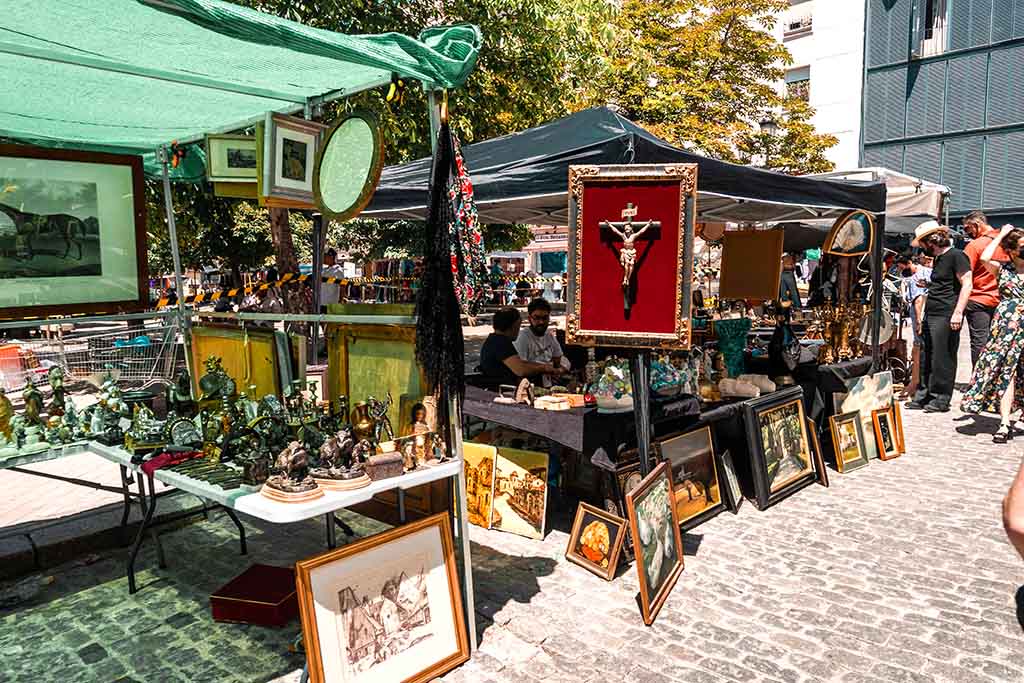
Pic by Victoria from Guide Your Travel
El Rastro, Madrid’s famous Sunday open-air market, is a treasure trove of antiques attracting history buffs and collectors. As you wander through the alleyways, you’ll discover a wide selection of vintage furniture, worn jewelry, and old artifacts; there is everything a collector’s heart desires.
Buying an antique at El Rastro is not just the purchase of an object but an investment in a tangible piece of history. The lively atmosphere of the market and the fascination of these artifacts make every purchase a timeless connection with Madrid’s fascinating heritage.
It’s best to come early in the morning as it can get really crowded. And don’t worry; there are small bars and restaurants everywhere along the market area to enjoy a cool drink and tapas while watching the hustle and bustle of the market.
By Victoria from Guide Your Travel.
13. Spanish Olives
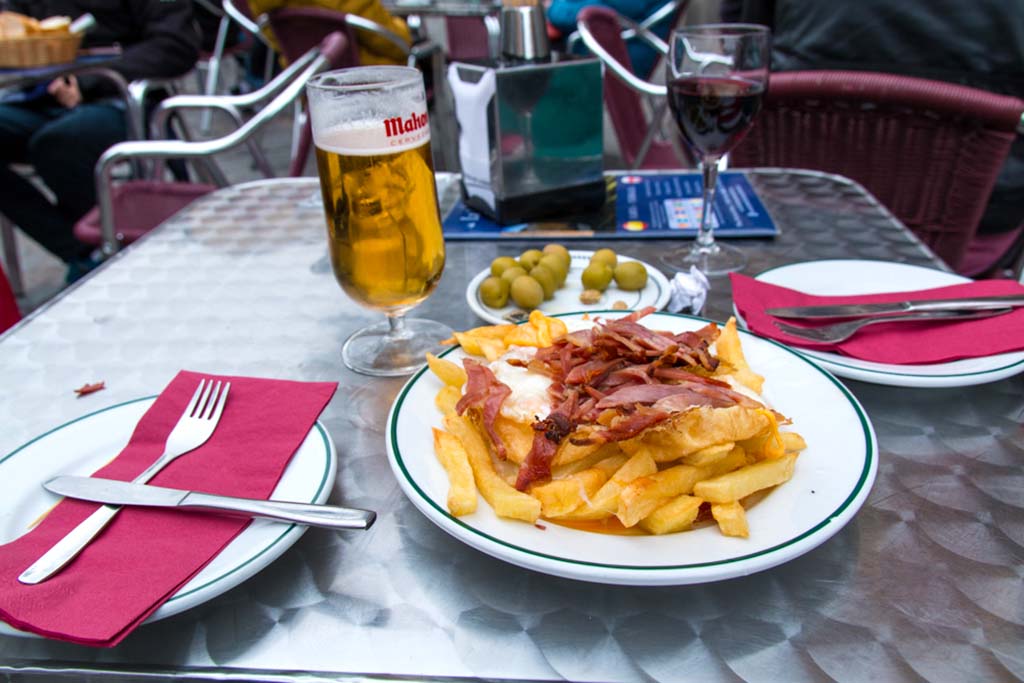
Pic by Heather with Arbours Abroad
One of the top things to do in Spain is to go out for tapas. Tapas are small appetizers served when purchasing drinks in Spain. When we were in Madrid, nearly all restaurants serving tapas began the first round of tapas with some form of an olive.
You can’t visit Spain without tasting Spanish olives. And what better souvenir than one that is edible. Bringing the taste of a country to someone is a way to win their heart!
Olives are a very traditional appetizer served with drinks, at homes, and even in the markets throughout Spain. The olives are grown locally, and then different places taking their own twists on seasoning and processing the olives, making olives a great souvenir from Spain.
By Heather with Arbours Abroad.
14. Iberian cured ham

Pic Carrie from The Day Dream Drifters
Iberian cured ham, one of the most popular souvenirs to buy in Spain, is a proud testament to Spanish gastronomy. Famous all around the world, this ham is salty, delicious, and doesn’t need to be refrigerated. Iberian cured ham is more than a mere treat – it embodies the history, culture, and passionate craftsmanship of Spanish charcuterie. Its deep flavors and exquisite textures capture the essence of Iberian Peninsula, making it a must-buy for anyone who wishes to savor a tangible piece of Spain’s legacy.
Make sure to buy from a place where they’re cutting the ham straight off the leg for best quality. Opt for a vacuum-sealed package, as most places offer it in this form. Upon arrival at home, store the ham in a cool, dry area to extend its shelf life. This will ensure your Spanish treasure remains delectable long after you’ve returned home!
By Carrie from The Day Dream Drifters.
15. El Caganer Barcelona
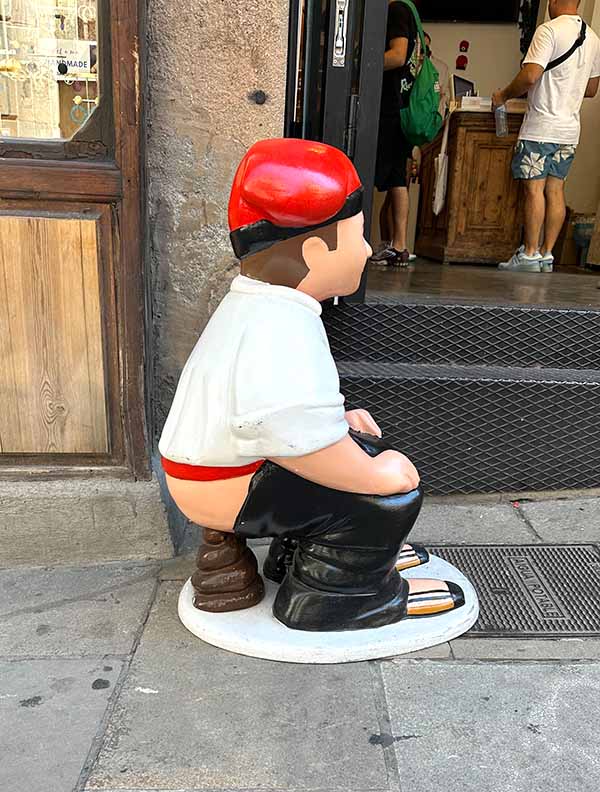
Pic by Becky from Cultivate Traveling
The Caganer figurine is of a man squatting to defecate. There is a rich Catalan tradition of the Caganer, where you’ll find not only the classic versions but also Caganers portraying your favorite cartoon characters and beloved celebrities.
Including el Caganer in the Catalan nativity scene has been a tradition for hundreds of years. Unlucky if excluded, this unique figurine is believed to bring blessings for the coming year. Its feces symbolize the fertilization of crops, a powerful testament to the circle of life.
The Catalan Christmas “Pooper” is a quirky and beloved tradition that dates all the way back to the 18th century! The figurine portrays a Catalan farmer, complete with a distinctive red cap called a barretine, dark pants, red sash, and a white shirt.
But here’s the real twist: in the nativity scene, the Caganer isn’t placed front and center like the main characters. Instead, he’s cleverly hidden away, doing his business behind the scenes. Surprisingly, he’s considered just as important as iconic figures like Jesus, Mary, and Joseph.
So, why not embrace the playful spirit of Catalonia this Christmas and add this unique and quirky tradition to your own festive display? The Caganer is sure to bring a smile to the faces of all your guests and become an instant conversation-starter. Spread some holiday cheer with a touch of Catalan charm.
If you want to bring el Caganer home as a souvenir to bless your new year, there are many places in Barcelona to buy one. There are stores all over Barcelona dedicated to him. He can also found at the cities’ Christmas Markets.
By Becky from Cultivate Traveling.
16. Paella Pan

Pic by Lavina from Continent Hop
People all over Spain love paella which is a dish made with rice, saffron, different kinds of meat, and fish. The paella pan serves one purpose – making paella! This pan is one of a kind because it is wide, flat, and has sides that slope slightly. This shape allows each grain of rice to absorb the flavours fully. The pan is made of steel which makes it durable and perfect to buy as a souvenir. Enhance your Barcelona itinerary 5 days by using a Paella Pan to recreate the city’s iconic flavours.
In addition to being a great souvenir that shows off Spanish culture, you can also use it in your daily life. Food lovers and people who like to cook will benefit the most from it.
The Paella Pan is a great addition to your kitchen and the perfect aid when you want to recreate Spain’s flavours once you’re back.
By Lavina D’Souza of Continent Hop.
17. Bottle of Wine

Pic by Vicki from Vickiviaja
Spain is known for many things, but especially for its excellent wine. Spanish wine is not only a popular Spanish drink but also a treasured souvenir that will remind you and your loved ones at home of a beautiful vacation in Spain for a long time to come.
Thanks to its different climate zones, the country offers a wide variety of different types of wines. Your choice of which bottle to take home should, therefore, depend on the region you are visiting. You will find highly regarded wines in La Rioja, while in Catalonia, cava, a Spanish sparkling wine, is particularly recommended.
Prices for Spanish wine vary: A simple bottle is available from around €5, while you can expect to pay €15-20 for high-quality wine. Anyway, prices for top wines are open-ended.
By Vicki from Vickiviaja.
18. Ratafia
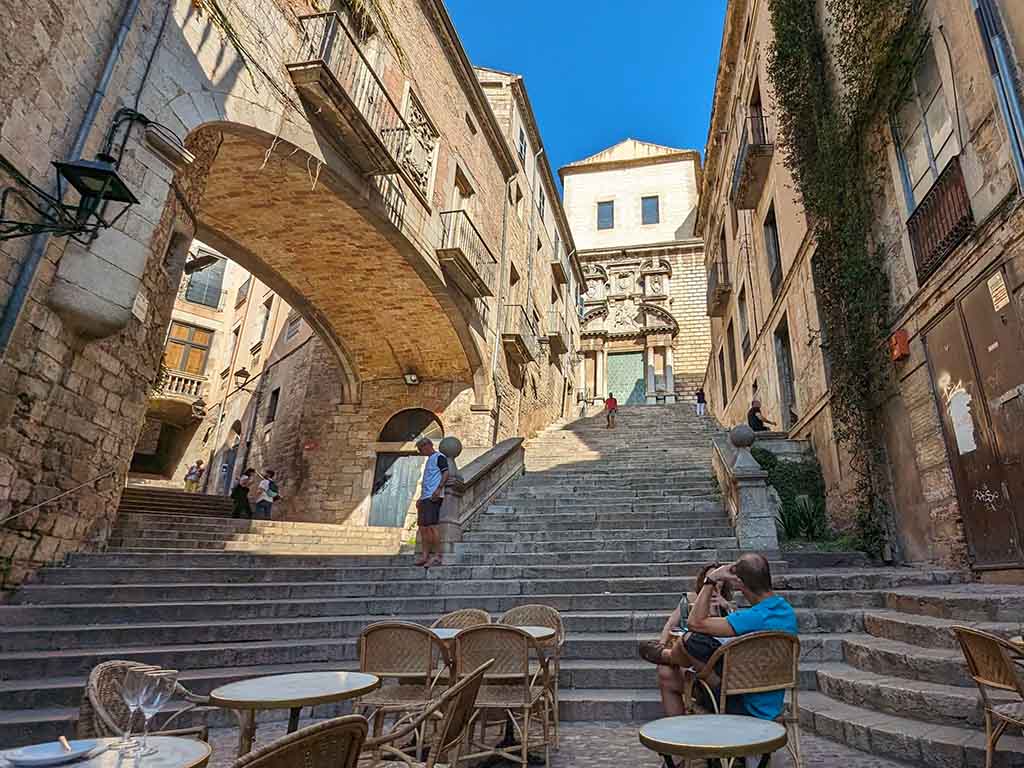
Pic by Melissa from Mountains and Mahals
When visiting Catalonia in Spain, you shouldn’t miss out on trying Ratafia. This traditional Catalan liqueur is made from blending fruits, nuts, spices, and herbs with alcohol. The sweet drink is a mix of flavors, often including walnuts, lemon peels, cinnamon, and various other botanicals that vary from one recipe to another.
The richly flavored spirit has its origins in Catalonia, although similar versions exist in other parts of Europe. The name ‘Ratafia’ comes from the Latin phrase “rata fiat” which translates to “the deal is done,” since historically agreements were often sealed with a drink.
You’ll be able to readily find Ratafia in Catalonia, where you can visit local distilleries and wineries that produce their own versions. The town of Santa Coloma de Farners hosts the annual Ratafia Festival. Girona is another excellent place to try Ratafia at a quaint tavern or wine bar. Check out Cafe le Bistrot for the perfect spot to enjoy Ratafia on their terrace in the old town.
Remember you are allowed to pack up to five liters of alcohol duty-free in your checked luggage when returning to the United States.
By Melissa from Mountains and Mahals
Other Posts To Read
- 7 Historical Facts About The Colosseum To Know
- Military Fortress Montjuic
- Of gold and things
- Tung Fort Trek
- What to buy in Rome


